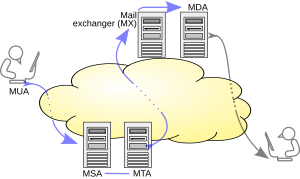邮件处理过程
Mail processing model

Email is submitted by a mail client (MUA, mail user agent) to a mail server (MSA, mail submission agent) using SMTP on TCP port 587. Most mailbox providers still allow submission on traditional port 25. From there, the MSA delivers the mail to its mail transfer agent (MTA, mail transfer agent). Often, these two agents are just different instances of the same software launched with different options on the same machine. Local processing can be done either on a single machine, or split among various appliances; in the former case, involved processes can share files; in the latter case, SMTP is used to transfer the message internally, with each host configured to use the next appliance as a smart host. Each process is an MTA in its own right; that is, an SMTP server.
The boundary MTA has to locate the target host. It uses the Domain name system (DNS) to look up the mail exchanger record (MX record) for the recipient's domain (the part of the address on the right of @). The returned MX record contains the name of the target host. The MTA next connects to the exchange server as an SMTP client. (The article on MX record discusses many factors in determining which server the sending MTA connects to.)
Once the MX target accepts the incoming message, it hands it to a mail delivery agent (MDA) for local mail delivery. An MDA is able to save messages in the relevant mailbox format. Again, mail reception can be done using many computers or just one ―the picture displays two nearby boxes in either case. An MDA may deliver messages directly to storage, or forward them over a network using SMTP, or any other means, including the Local Mail Transfer Protocol (LMTP), a derivative of SMTP designed for this purpose.
Once delivered to the local mail server, the mail is stored for batch retrieval by authenticated mail clients (MUAs). Mail is retrieved by end-user applications, called email clients, using Internet Message Access Protocol (IMAP), a protocol that both facilitates access to mail and manages stored mail, or the Post Office Protocol (POP) which typically uses the traditional mboxmail file format or a proprietary system such as Microsoft Exchange/Outlook or Lotus Notes/ Domino. Webmail clients may use either method, but the retrieval protocol is often not a formal standard.
SMTP defines message
transport, not the message
content. Thus, it defines the mail
envelope and its parameters, such as the envelope sender, but not the header or the body of the message itself. STD 10 and RFC 5321 define SMTP (the envelope), while STD 11 and RFC 5322 define the message (header and body), formally referred to as the Internet Message Format.